NASA Explains Why June 30 Will Get Extra Second
Credits: NASA Goddard Space Flight Center
Originally developed to study distant astronomical objects called quasars, the technique called Very Long Baseline Interferometry provides information about the relative locations of observing stations and about Earth’s rotation
and orientation in space.The day will officially be a bit longer than usual on Tuesday, June 30, 2015, because an extra second, or “leap” second, will be added.
and orientation in space.The day will officially be a bit longer than usual on Tuesday, June 30, 2015, because an extra second, or “leap” second, will be added.
“Earth’s rotation is gradually slowing down a bit, so leap seconds are a way to account for that,
” said Daniel MacMillan of NASA’s Goddard Space Flight Center in Greenbelt, Maryland.
” said Daniel MacMillan of NASA’s Goddard Space Flight Center in Greenbelt, Maryland.
Strictly speaking, a day lasts 86,400 seconds. That is the case, according to the time standard
that people use in their daily lives – Coordinated Universal Time, or UTC. UTC is “atomic time”
– the duration of one second is based on extremely predictable electromagnetic transitions in
atoms of cesium. These transitions are so reliable that the cesium clock is accurate to one
second in 1,400,000 years.
that people use in their daily lives – Coordinated Universal Time, or UTC. UTC is “atomic time”
– the duration of one second is based on extremely predictable electromagnetic transitions in
atoms of cesium. These transitions are so reliable that the cesium clock is accurate to one
second in 1,400,000 years.
However, the mean solar day – the average length of a day, based on how long it takes
Earth to rotate – is about 86,400.002 seconds long. That’s because Earth’s rotation is
gradually slowing down a bit, due to a kind of braking force caused by the gravitational
tug of war between Earth, the moon and the sun. Scientists estimate that the mean solar
day hasn’t been 86,400 seconds long since the year 1820 or so.
Earth to rotate – is about 86,400.002 seconds long. That’s because Earth’s rotation is
gradually slowing down a bit, due to a kind of braking force caused by the gravitational
tug of war between Earth, the moon and the sun. Scientists estimate that the mean solar
day hasn’t been 86,400 seconds long since the year 1820 or so.
































